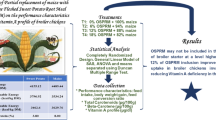Abstract
Four diets were formulated with protein from fishmeal (FM), groundnut cake (GC), ensiled sweet potato (Ipomoea batatas L. (Lam.)) leaves (SP) or ensiled sweet potato leaves with lysine (SPL). In experiment 1, 24 crossbred (Large White×Mong Cai) growing pigs were allocated randomly by sex into four groups of six pigs and given one of four diets. Experiment 2 was conducted using 16 crossbred pigs (Large White×Mong Cai) at four farms. On each farm, pigs were allocated to two experimental groups. One group was fed the FM diet and the other group the SPL diet. In experiment 1, the daily live weight gains (DLWG) were significantly higher (p<0.05) for the FM and SPL treatments (542 and 536 g/day, respectively) than for the GC and SP treatments (464 and 482 g/day, respectively). Feed intake was highest (2.0 kg/day) for the SPL and lowest (1.7 kg/day) for the GC treatment (p<0.05) and feed conversion ratio (FCR) was highest (3.8 kg/kg gain) for SP and lowest (3.5 kg/kg gain) for FM (p<0.05). There were no significant differences for carcase measurements among diets (p>0.05). The feed cost per kg live weight gain was lowest for the SP and SPL diets compared to the FM and GC diets. The results of experiment 2 show that there were no significant differences in feed intake, DLWG and FCR between the two diets (p>0.05). In conclusion, sweet potato leaves can replace fishmeal and groundnut cake in traditional Vietnamese diets for growing pigs.
Similar content being viewed by others
REFERENCES
An, L.V., Lindberg, B.E.F. and Lindberg, J.E.,2003. Effect of harvesting interval and defoliation on yield and chemical composition of leaves, stems and tubers of sweet potato (Ipomoea batatas L. (Lam.)) plant parts. Field Crops Research, 82, 49–58
An, L.V., Hong, T.T.H. and Lindberg, J.E., 2004. Ileal and total tract digestibility in growing pigs fed cassava root meal diets with inclusion of fresh, dry and ensiled sweet potato (Ipomoea batatas L. (Lam.)) leaves. Animal Feed Sciences and Technology, 114, 127–139
Andersson, K., Schaub, A., Andersson, K., Kerstin, L., Thomke, S. and Hansson, I., 1997. The effects of feeding system, lysine level and gilt contact on performance, skatole levels and economy of entire male pigs. Livestock Production Science, 51, 131–140
AOAC, 1990. Official Methods of Analysis, 15th edn, (Association of Official Analytical Chemists, Arlington, VA)
Boisen, S. and Moughan, P.J., 1996. Difference expressions of dietary protein and amino acid digestibility in pig feeds and their application in protein evaluation: a theoretical approach. Acta Agriculturae Scandinavia, Section A, Animal Science, 46, 165–172
Dominguez, P.L. and Ly, J., 1997. An approach to the nutritional value for pigs of sweet potato vines (Ipomoea batatas (L.) Lam). Livestock Researchfor Rural Development, 9(2)
Dourmad, J.Y., Guillou, D., Sve, B. and Henry, Y., 1996. Response to dietary lysine supply during the finishing period in pigs. Livestock Production Science, 45, 179–186
Eggum, B.O., 1973. A study of certain factors influencing protein utilization in rats and pigs. Statens Husdyrbrugsudvalg, 406, Beretningfraforsogslaboratoriet, (Copenhagen, Denmark)
Hang, D.T., 1998. Ensiled cassava leaves and duckweed as protein sources for fattening pigs on farms in Central Vietnam. Livestock Researchfor Rural Development, 10(3)
Ishida, H., Suzuno, H., Sugiyama, N., Innami, S., Tadokoro, T. and Meakawa, A., 2000. Nutritive value on chemical components of leaves, stalks and stems of sweet potato (Ipomoea batatas Poir). Food Chemistry, 68, 359–367
Jin, C.F., Kim, J.H., Han, In K. and Bae, S.H., 1998. Effect of supplemental synthetic amino acids to the low protein diets on performance of growing pigs. Asian-Australasian Journal ofAnimal Science, 11, 1–7
Jondreville, C., Van Der Broecke, J., Grosjean, F., Van Cauwenberghe, S. and Gatel, F., 2000. Ileal true digestibility of amino acids in wheat milling by-products for pigs. Annales de Zootechnie, 49, 55–65
Kauffman, R.G. and Epley, R.J., 2000. Pork Industry Handbook, (US Grains Council, Agricultural Publishing House, Hanoi, Vietnam)
Lindberg, J.E. and Anderson, C., 1998. The nutritive value of barley-based diets with forage meal inclusion for growing pigs based on total tract digestibility and nitrogen utilization. Livestock Production Science, 56, 43–52
McDonald, P., Edwards, R.A., Greenhalgh, J.F.D. and Morgan, C.A., 1995. Animal Nutrition, 5th edn, (Longman Scientific and Technical, Harlow)
Mederos, C.M., Perez Valdivia, J.M., Piloto, J.L., Aleman, E. and Martinez, R.M., 2002. Protein level and amino acid supplementation in pigs fed sugar cane molasses. Growth performance and carcass traits. Livestock Research for Rural Development, 14(6)
Minitab, 1998. Minitab Reference Manual, Release 12 for Windows, (Minitab Inc., USA)
Mora, L., Dominguez, P. L., Calderon, R. and Quintano, J., 1992. Notes on the use of sweet potato (Ipomoea batatas) foliage in diets for weaned pigs. Zootechnia de Cuba, 2, 85–90
NIAH (National Institute of Animal Husbandry), 1995. Composition and Nutritive Value of Animal Feeds in Vietnam, (Agricultural Publishing House, Hanoi, Vietnam)
Phuc, B.H.N., 2000. Tropicalforages for growing pigs, (PhD thesis, Agraria 247, Swedish University of Agricultural Sciences)
Ramaekers, P.J.L., Swinkels, J.W.G.M., Huikes, J.H. Verstegen, M.W.A., Den Hartog, L.A. and Van der Peet-Schwering, C.M.C., 1996. Performance and carcass traits of individual pigs housed in groups as affected by ad libitum and restricted feeding. Livestock Production Science, 47, 43–50
Scipioni, R. and Martelli, G., 2001. Consequences of the use of ensiled sugar beet-pulp in the diet of heavy pigs on performances, carcass characteristics and nitrogen balance: a review. Animal Feed Science Technology, 90 , 81–91
Woolfe, J.A., 1992. Sweet Potato: An Untapped Food Resource, (Cambridge University Press, Cambridge)
Author information
Authors and Affiliations
Rights and permissions
About this article
Cite this article
Van An, L., Hong, T., Ogle, B. et al. Utilization of Ensiled Sweet Potato (Ipomoea batatas (L.) Lam.) Leaves as a Protein Supplement in Diets for Growing Pigs. Tropical Animal Health and Production 37, 77–88 (2005). https://doi.org/10.1023/B:TROP.0000047937.41355.4d
Issue Date:
DOI: https://doi.org/10.1023/B:TROP.0000047937.41355.4d



